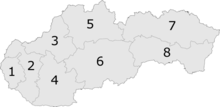............................................................................................................................................................................................................................
History
The Slavs arrived in the territory of present day Slovakia in the fifth and sixth centuries during the migration period. In the course of history, various parts of today's Slovakia belonged to Samo's Empire (the first known political unit of Slavs), Principality of Nitra (as independent polity, as part of Great Moravia and as part of Hungarian Kingdom), Great Moravia, Kingdom of Hungary, the Austro-Hungarian Empire or Habsburg Empire, and Czechoslovakia. A separate Slovak state briefly existed during World War II, during which Slovakia was a dependency of Nazi Germany between 1939–1944. From 1945 Slovakia once again became a part of Czechoslovakia. The present-day Slovakia became an indipendent state on 1 January 1993 after the peaceful dissolution of Czechslovakia.
Slovakia is a high-income advaced economy ith one of the fastest growth rates in the European Union and the OECD. The country joined the European Union in 2004 and the Eurozone on 1 January 2009. Slovakia together with Slovenia are the only former Communist nations to be part of the European Union,Eurozone,Schengen Area and NATO simultaneously.
.......................................................................................................................................................................................................................................
Geografy
Major Slovak rivers are the Danube, the Vah and the Hron. The Tisa marks the Slovak-Hungarian border for only5 km (3.1 mi).
The Slovak climate lies between the temperate and continental climate zones with relatively warm summers and cold, cloudy and humid winters. The area of Slovakia can be divided into three kinds of climatic zones and the first zone can be divided into two sub-zones.
.......................................................................................................................................................................................................................................
Regions and districts

- Bratislava Region (capital Bratislava)
- Trnava Region (capital Trnava)
- Trencin Region (capital Trencin)
- Nitra Region (capital Nitra)
- Zilina Region (capital Zilina)
- Banska Bystrica Region (capital Banska Bystrica)
- Presov Region (capital Presov)
- Kosice Region (capital Kosice)
........................................................................................................................................................................................................................................
River
..................................................................................................................................................................................................................................................
